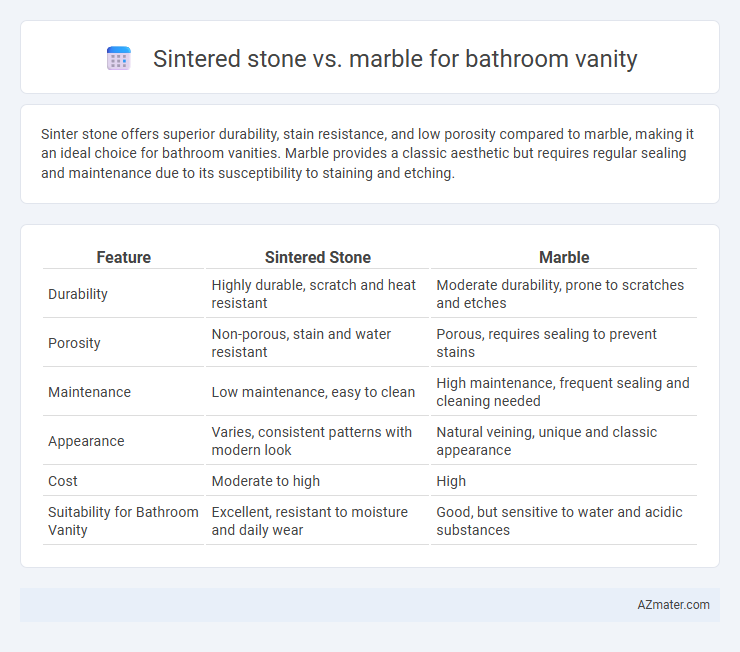Sinter stone offers superior durability, stain resistance, and low porosity compared to marble, making it an ideal choice for bathroom vanities. Marble provides a classic aesthetic but requires regular sealing and maintenance due to its susceptibility to staining and etching.
Table of Comparison
| Feature | Sintered Stone | Marble |
|---|---|---|
| Durability | Highly durable, scratch and heat resistant | Moderate durability, prone to scratches and etches |
| Porosity | Non-porous, stain and water resistant | Porous, requires sealing to prevent stains |
| Maintenance | Low maintenance, easy to clean | High maintenance, frequent sealing and cleaning needed |
| Appearance | Varies, consistent patterns with modern look | Natural veining, unique and classic appearance |
| Cost | Moderate to high | High |
| Suitability for Bathroom Vanity | Excellent, resistant to moisture and daily wear | Good, but sensitive to water and acidic substances |
Overview: Sinter Stone vs Marble for Bathroom Vanities
Sinter stone offers superior durability and resistance to stains, scratches, and heat compared to marble, making it ideal for high-use bathroom vanities. Marble is prized for its timeless elegance and unique veining but requires regular sealing and maintenance to prevent etching and discoloration. Both materials provide aesthetic appeal, but sinter stone is favored for low-maintenance and long-lasting performance in wet environments.
Composition and Manufacturing Differences
Sinter stone, composed of natural quartz and ceramic particles, undergoes a high-pressure sintering process that fuses the materials without resins, resulting in a dense, durable surface resistant to heat and scratches. In contrast, marble is a natural metamorphic rock primarily composed of calcite, quarried and cut into slabs with inherent porousness and susceptibility to etching from acids. Sinter stone's engineered manufacturing enhances uniformity and non-porosity, making it more suitable for bathroom vanities requiring hygiene and low maintenance, whereas marble's natural veining and variation provide unique aesthetics but demand more care.
Appearance and Aesthetic Options
Sintered stone offers a highly durable surface with a variety of colors and patterns that mimic natural stone, providing a sleek and modern aesthetic ideal for contemporary bathroom vanities. Marble showcases unique veining and a luxurious, timeless look that enhances classic and elegant designs, although it requires more maintenance due to its porous nature. Both materials deliver distinct visual appeal, with sintered stone emphasizing versatility and durability, while marble emphasizes natural beauty and sophistication.
Durability and Longevity
Sintered stone offers superior durability and resistance to scratches, stains, and heat compared to marble, making it ideal for bathroom vanities exposed to daily wear. Marble, while elegant and timeless, is more porous and prone to etching and staining, requiring regular sealing to maintain its appearance. The long-term longevity of sintered stone surpasses marble, ensuring a low-maintenance, resilient surface that retains its look over years of use.
Resistance to Stains and Scratches
Sintered stone offers superior resistance to stains and scratches compared to marble, making it a highly durable choice for bathroom vanities. Its non-porous surface prevents absorption of liquids and resists everyday wear, while marble requires regular sealing to protect against stains and can be easily scratched by sharp objects. For long-term maintenance and durability, sintered stone provides a practical advantage over marble in wet and high-use bathroom environments.
Maintenance and Cleaning Requirements
Sinter stone offers superior stain resistance and requires minimal maintenance compared to marble, as it is non-porous and less prone to etching or scratching. Marble demands regular sealing to protect against moisture and acidic substances commonly found in bathrooms, making its upkeep more labor-intensive. Cleaning sinter stone involves simple wiping with mild soap and water, while marble necessitates specialized cleaners to preserve its polished surface and prevent damage.
Cost Comparison: Sinter Stone vs Marble
Sinter stone typically costs between $50 to $100 per square foot, making it a more budget-friendly option compared to marble, which ranges from $75 to $150 per square foot. The price difference is influenced by sinter stone's durability and low maintenance, reducing long-term expenses despite the higher upfront cost of marble. Homeowners seeking a luxury appearance often pay a premium for marble's unique veining and natural elegance, while sinter stone provides a cost-effective, resilient alternative for bathroom vanities.
Installation Process and Considerations
Sintered stone offers a lightweight and durable option for bathroom vanity installation, requiring minimal support due to its thin, slab-like form and uniform thickness, which simplifies cutting and fitting around plumbing fixtures. Marble demands careful handling during installation because of its weight and susceptibility to chipping; it often necessitates stronger substructures and precise sealing to prevent water damage. Choosing sintered stone reduces installation complexity and long-term maintenance concerns, while marble provides classic aesthetics but involves higher labor costs and meticulous installation practices.
Environmental Impact and Sustainability
Sintered stone offers superior environmental benefits compared to marble, as it is manufactured using natural minerals combined with eco-friendly processes that reduce waste and energy consumption. Marble extraction involves quarrying, leading to significant habitat disruption, high water usage, and carbon emissions, making it less sustainable. Choosing sintered stone supports longevity and recyclability due to its durability and non-porous surface, which minimizes the need for harsh chemicals and frequent replacements in bathroom vanities.
Choosing the Best Material for Your Bathroom Vanity
Sintered stone offers exceptional durability and resistance to scratches, heat, and stains, making it an ideal choice for bathroom vanities in high-traffic or moisture-prone areas. Marble provides timeless beauty and unique veining, but requires more maintenance due to its porosity and susceptibility to etching from acidic substances. Selecting between sintered stone and marble depends on the balance between aesthetic preference and practical durability for your bathroom environment.

Infographic: Sinter stone vs Marble for Bathroom vanity
 azmater.com
azmater.com